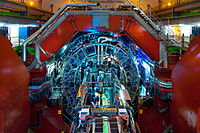
Photo from wikipedia
Resistive Plate Chambers (RPC) are cost-effective gaseous detectors with a very good time and spatial resolution which are extensively used in High Energy Physics and Astroparticle experiments. RPCs have also… Click to show full abstract
Resistive Plate Chambers (RPC) are cost-effective gaseous detectors with a very good time and spatial resolution which are extensively used in High Energy Physics and Astroparticle experiments. RPCs have also proposed for Time-Of-Flight (TOF) measurements in Positron Emission Tomography (PET) imaging systems. However, the major limitation of common RPC detectors for PET imaging systems is their low detection efficiency for 511 keV gammas. This paper is focused on the development and investigation of a new RPC detector with improved detection efficiency and time resolution for TOF measurement of 511 keV gamma pairs from electron-positron annihilation. The proposed double-stack Multi-gap RPC (MRPC) detector which is optimized for TOF-PET, consists of 20 gas gaps (with 150 μm width) with 180 μm glass slides (with 24% PbO) as resistive plates in optimum thickness to act as the gamma to electron converter. The proposed detector can work at lower applied voltage with higher count rate capability thanks to the double-stack design and smaller gas gaps width in comparison to common RPCs which were used for TOF-PET applications. The experimental detection efficiency of the proposed MRPC detector for single 511 keV gammas is around 8.3%. At higher applied voltages although the electron multiplication of detector increases, but the detection efficiency saturates, which is related to saturation of dark count rate noise. By using the experimental TOF measurement for electron-positron annihilation gammas, the calculated timing standard deviation of each MRPC detector is 194±40 ps. Moreover, in previous work with the proposed detector it was proved that by using a suitable arrangement of vertical and horizontal readout strips, the pixelated detector can be formed to extract the spatial information of the interaction. According to these results, the proposed prototype detector (which is the first double-stack mode MRPC with 20 gas gaps for TOF-PET application) could be a candidate for TOF measurement system thanks to its suitable time and spatial resolution and also reasonable rate capability. Therefore, it could be an inexpensive alternative for commercial TOF-PET detectors.
Journal Title: Journal of Instrumentation
Year Published: 2020
Link to full text (if available)
Share on Social Media: Sign Up to like & get
recommendations!